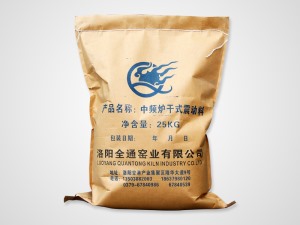Talking about the performance and application of refractory ramming material
Compared with other unshaped refractories of the same material, the ramming material is in a dry or semi-dry loose shape, and has no cohesiveness before forming, so a dense structure can be obtained only by strong ramming. Most ramming materials The strength at room temperature before sintering is low, and some are not high in strength at medium temperature. Only after sintering or coking of the carbon-containing compound in the binder can a strong bond be obtained.
The refractoriness and corrosion resistance of the ramming material can be obtained by selecting refractory materials, selecting the correct ratio and strong tamping. Compared with castables and plastics, it has higher stability and resistance at high temperatures. Aggressive. However, its service life also depends to a large extent on the pre-burning before use or the amount of sintering in the next use. If the heating surface is sintered as a whole without cracks and is not separated from the bottom layer, the service life can be Improve progress.
In addition to the construction of the ramming material at room temperature, when the thermoplastic organic material that can form carbon bonding is used as the binder, the method of hot mixing is often adopted. After the mixture is evenly mixed, the construction is performed immediately.
After forming, according to the strengthening characteristics of the mixture, different heating methods are adopted to promote its hardening or sintering. For those containing inorganic chemical binders, the mold can be demolded and baked after self-hardening to an appropriate strength; for those containing thermoplastic carbon binders, wait After cooling, it should be demolded with appropriate strength. After demolding, it should be quickly heated to make it coking; for those without binders that harden at room temperature, sintering is often carried out with a die after tamping. When the ramming material is only added with 1%-2% boric acid to make the lining of the electric induction furnace, the mixture can be filled into the iron core mold for tamping, and then it can be heated and sintered by electricity. The sintering of the ramming material lining can be carried out in advance before use. It can also be completed by heat treatment with appropriate thermal engineering standards in the next use.
Ramming material is mainly used as a lining material in various smelting furnaces that are in direct contact with molten materials. In addition to forming the entire furnace lining, it can also be used to make large products.

Related News
- Introduction of construction method of ramming material in intermediate frequency furnace
- How to choose the material of furnace lining
- The difference between rammer and castable
- Application direction of intermediate frequency furnace refining
- Introduction to the construction method of dry ramming material
- Do you know the production process and control points of breathable bricks?
- The application of argon blowing technology at the bottom of the intermediate frequency furnace
- Method for prolonging service life of intermediate frequency furnace lining
- In addition to diffused breathable bricks, there are those types of breathable bricks
- What are the advantages of coil cement
- What are the characteristics and advantages of coil cement?
- The conditions required for the selection of intermediate frequency furnace charge
- Precautions for the construction of coil cement
- What are the functional advantages of coil cement?
- 5 benefits of using dry ramming mixes
- What are the ways to extend the life of the intermediate frequency furnace lining?
- What are the reasons for the damage of ladle breathable bricks?
- How to prolong the service life of intermediate frequency furnace lining
- Where are the primary characteristics of the intermediate frequency furnace charge?
- Why does the ramming material of the intermediate frequency furnace pass through the furnace?


